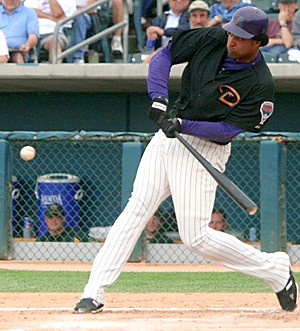The Clark Connection
Everybody knows about the Arizona basketball program’s track record in producing NBA draft picks.
Arizona head coach Lute Olson’s program has produced more picks, 26, than any other program in the country since its rise to dominance in 1989.
What is less known is that Olson has had comparative success in producing professional baseball talent among major college basketball programs, as Los Angeles Dodgers outfielder Kenny Lofton and Arizona Diamondbacks first baseman Tony Clark have passed through the system.
Clark, a 6-foot-7, 245-pound mountain of a man who looks like he could just as easily be playing power forward for the Phoenix Suns as first base for the Diamondbacks, has taken a different path than most of Olson’s other eventual professionals. Many of Olson’s players have been all-around athletes who excelled in other sports in high school, but Clark himself never thought he would be a pro baseball player.
“”As a matter of fact, I’d have been willing to take bets that basketball was (my sport),”” Clark said. “”That’s what I had thought, but an injury in that first year kind of changed things around for the years after, so I’m obviously thankful for the way things worked out.””
More than 15 years later, Clark, now 33, has seemingly come full circle in his career, as it has taken him back to Tucson, where he concluded his second training camp with the Diamondbacks last week.
The semester with the Cats
Clark played for Arizona during the fall semester of 1990, when Arizona’s frontcourt was loaded with Sean Rooks, Brian Williams and Ed Stokes, and Chris Mills was set to transfer in.
“”We did have a lot of talent at the time,”” said Arizona associate head coach Jim Rosborough, an Arizona assistant since 1989. “”You just go right up and down the line.””
After the Wildcats won the Dodge N.I.T. in December 1990 in New York City, Rosborough said Clark “”came in and actually did a pretty darn good job,”” but the next thing the Wildcats knew, Clark was gone.
Like many of Arizona head coach Lute Olson’s previous players with a glut of talent in front of them, he decided to transfer. Clark went to his hometown school, San Diego State, where he was the Aztecs’ leading scorer in 1991-92, averaging 11.5 points per game.
“”It was a lot of fun, it really was. I look back,
obviously, and wish my stay could have been longer.””
D’Backs first baseman
“”He would have been a very good player here,”” Rosborough said. “”He could run, jump and had a good attitude. He was a terrific athlete and a phenomenal scorer and would have been fine here.””
Having played under Olson for a semester, Clark said he learned composure.
“”That was one of those things,”” Clark said. “”He never seemed to lose his composure, and that helped keep us cool.””
“”It was a lot of fun, it really was,”” he said. “”I look back, obviously, and wish my stay could have been longer.””
In coming back for spring training, Clark said he has noticed Tucson’s growth over the years, saying the city was pretty much just the Arizona campus during his semester as a Wildcat.
“”There wasn’t a whole lot else going on around here, and basketball was very high on the priority list, not that that’s changed, just that there’s more people down here and more things going on,”” he said. “”It was kind of interesting to drive back down here last spring, being the first time I’ve been back down here.””
The 30-homer backup
Clark signed a modest one-year, $750,000 contract with the Diamondbacks last season after a year with the New York Yankees, and the club expected he would bring a solid bat off the bench and some veteran leadership.
What it didn’t figure was that Clark would be named Arizona’s Player of the Year by the Arizona chapter of the Baseball Writers’ Association of America after ranking second on the team in batting average (.304), home runs (30) and RBIs (87).
Clark also led all major league pinch hitters with 15 RBIs off the bench, second in club history. He hit the most home runs for a switch hitter in Diamondbacks history, going deep once ever 11.63 at-bats, which ranked second behind Atlanta center fielder Andruw Jones for best in baseball.
However, Jones, last year’s major league leader in home runs with 51, went to the plate 237 more times than Clark.
For all that, what did Clark get over the offseason?
A modest two-year contract extension and a seat on the bench with topflight first-base prospect Conor Jackson ready to take over the reins.
“”This game humbles you very quickly,”” Clark said. “”Me being here has less to do with how many home runs I can hit and more with the responsibility to my teammates and the ball club and doing my part to help us win ballgames.””
However, Jackson understands the man behind him can do the job.
“”I’ve got to get hot, stay hot right away because coming off a year like that. … I don’t think I’ve got much leeway,”” Jackson said. “”The string’s pretty short over there.””
The mentor
While Clark’s big bat helped Arizona win a number of games, his role as a mentor may be most important to the development of the Diamondbacks’ future.
“”He’s an open door,”” Jackson said. “”When I have something I need answered, he’s probably the first guy I really would go to.””
A year removed from helping out third baseman Chad Tracy, who shared time at first with Clark last year and is now slated to hit No. 3 in the order, Clark is one of the club’s veteran presence for a team that figures to be young in the field the next two seasons.
According to Baseball America, the Diamondbacks have five of the top 23 prospects in all of baseball, all position players estimated to make it to the big leagues in the next two years.
That includes Jackson, the No. 17 prospect overall, who shared time with Clark last year after being called up July 28, and has now taken Clark’s spot in the field as well as the fifth spot in the batting order.
“”Especially in the situation we’re both in this year, a lot of people would handle it a lot differently,”” Jackson said. “”I probably can’t count on my hand how many guys would have taken it the way that he did. We spoke a lot, and he’s helped me out quite a bit.””
Clark said he can most benefit the club through his experience.
“”Anything I can offer him on the field or off the field, I’ll throw out my two cents because he’s going to be fantastic,”” Clark said.
The Good Guy
In a clubhouse known as one of the best in baseball, Clark won the Diamondbacks’ Good Guy Award as voted by the Arizona chapter of the BBWAA.
“”(He’s) one of the best in baseball,”” Jackson said. “”There’s no doubt about it. You can ask anybody in this clubhouse, he’s probably one of the better guys that has played the game.
“”Off the field he’s just a big part of the community, and he’s like that in the offseason. He gives you (his) number and feel free to call him any(time). He’s a wonderful man.””
Clark is involved in a number of charities, including Baseball Tomorrow Fund’s equipment drive and the MVP (Maximum Valuable Potential) Foundation, which helps kids reach their goals through education and athletics. He also coached the Northwest Christian High School boys basketball team last offseason and earned the Circle of Champions award last October for his work with Arizona’s youth.
“”He’s a caring man,”” said infielder Damion Easley, Clark’s neighbor in Glendale and one of his best friends on the team, who signed with Arizona this offseason in large part because of Clark. “”He’s always trying to do some community work.
“”He’s big on education and helping kids with an opportunity to create an opportunity for themselves. He’s just always looking out for others.””
Said Clark: “”We have an opportunity because of what we do to have a positive effect on our community. I show it in the town that I live in year-round.””
The Budinger connection
While Clark’s days as a San Diego high school basketball star are long over, Easley said they still play some pickup basketball while working out together over the summer, saying Clark can still shoot and has some range.
The 6-foot-2 Jackson isn’t brave enough to try taking him on the court.
“”He’s a little intimidating, I’ll tell you what,”” Jackson said. “”I’m a little scared to play a little b-ball with him, (a) small white guy over here.””
In a unique way, Clark is still connected to the Arizona basketball program more than having his ear to the wall concerning how the Wildcats are doing.
Arizona basketball’s blue chip 2006 recruit Chase Budinger, a forward, broke the CIF San Diego Section scoring record this year that Clark held from 1990 to 2004, as Clark averaged 43.7 points per game his senior year on his way to a career 2,549 points.
Budinger, a two-sport star in volleyball as well as basketball in high school, averaged 32.7 his final campaign to rack up 2,930.
“”I’m happy for him, obviously,”” Clark said. “”I hope it translates into a long, successful career for him, but records are always made to be broken, so I was excited to hear that he was knocking on the door, and he actually got it.””
When Budinger needs guidance on how to become the next great professional athlete who spent time at Arizona, he need not look any further than a fellow San Diego basketball prep star for advice on how to get there.









